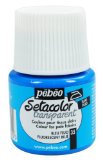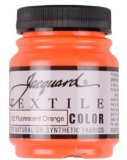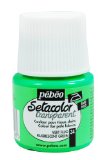Is it possible to permanently UV-dye a climbing rope?
Is it possible to permanently UV-dye a climbing rope?
Name: Jim
—ADVERTISEMENTS—

Jacquard Acid Dye Hot Fuchsia
Jacquard's Hot Fuchsia acid dye is a fluorescent pink true dye for wool, silk, and nylon. Like all fluorescent dyes, it fades in bright light.

Pebeo Setacolor Transparent Fabric Paint 45-Milliliter Bottle, Fluorescent Blue

Jacquard Textile Colors fluorescent orange

Pebeo Setacolor Transparent Fabric Paint, Fluorescent Green
Country or region: UK
Message: Please can you help. I want to UV permanently dye "climbing rope". I would like to know how permanent does "permanent" mean. I know this may be a shot in the dark idea, but if you could help I would be most grateful.
Can you tell me what the rope is made of? Nylon can be dyed pretty well, but polypropylene is hopeless and cannot even be painted.
What do you mean by "UV permanently dye"? Are you talking about a fluorescent dye, which absorbs ultraviolet light and then re-emits the energy as visible light?
Can you tell me what the rope is made of? Nylon can be dyed pretty well, but polypropylene is hopeless and cannot even be painted.
What do you mean by "UV permanently dye"? Are you talking about a fluorescent dye, which absorbs ultraviolet light and then re-emits the energy as visible light?
Thanks very much for your e-mail. I am pretty sure the rope is nylon. What I want to do is immerse the rope in a UV dye solution for a period of time, allow it to dry out and to be able to "see" the rope using a black UV light source.
If this feasible then what sort of dye and colour would be the most appropriate and how long would the dye last for if often used ?
Hoping you can help.
"Black light" is ultraviolet light, which is invisible to our eyes. The dyes and pigments that absorb black light and then emit light that we can see are called fluorescent.
It's not impossible to find a good fluorescent dye for nylon (in fact, it's much easier than finding one for cotton), but, unfortunately, the absorption of the energy in ultraviolet light makes all of these dyes very susceptible to light damage. There is no such thing as a truly permanent fluorescent dye. Your ropes will have to be re-dyed after too much exposure to bright light. I very much doubt their brightness would survive even a month left exposed to daily bright sun all day long, maybe not even a week. Be sure to store them in a dark place when they are not being displayed or used.
Note that some nylons have chemical coatings that prevent dyes from getting into the fiber. Always test-dye a small sample before spending too much time or money on a project.
You can't dye nylon by immersing it in room-temperature dye. The best dyes for Nylon dyes are acid dyes, which require heating. It's not enough to start with hot water in your dyebath; you must do your dyeing in a cooking pot, so that you can maintain the high temperature for some time. Don't use an aluminum cooking pot for this purpose, since aluminum reacts badly with the mild acids (such as vinegar) used along with acid dyes, and don't plan to reuse your dyeing pot for food preparation, because some fluorescent dyes are somewhat toxic and might be mildly carcinogenic, and no real textile dyes have been cleared for safety when used in food. Be careful to keep the temperature of your dyebath no higher than 96°C (which is 205°F), and use something in the bottom of your pot as a spacer to prevent your nylon from contacting any hot spots where the metal is thinner on the bottom of your dyeing pot. A hot spot may damage and weaken the nylon.
Where to buy fluorescent acid dyes for nylon in the UK? I'm finding it difficult to find more than one or two colors in your country. The dye supplier George Weil sells Jacquard Acid Dyes, but there's only one fluorescent acid dye in that line of dyes, the hot pink Rhodamine B (also known as Colour Index Acid Red 52, or Jacquard's 620 Hot Fuchsia). Like all fluorescent textile dyes, its lightfastness is poor, so it will fade relatively quickly in bright sunlight.
Flavine Yellow is another fluorescent acid dye, sold in the US by PRO Chemical & Dye, which should be available elsewhere. Its generic name is Colour Index Acid Yellow 7, and ProChem's name is Washfast Acid 107A Flavine Yellow G. A web search for ("acid yellow 7" AND UK) turns up some possible sources, such as WA Products (UK) Ltd. You would do best to look up the recipe for ProChem's "Immersion Dyeing on Nylon using WashFast Acid Dyes" [PDF], as the instructions given by WA Products are for an entirely different use. Note that, again, as with all true fluorescent dyes, acid yellow 7 fades quickly in bright sunlight.
The best source I know for multiple colors of fluorescent dyes for nylon is Aljo Mfg, in New York, in the US. Although you can examine their line of products online, they require orders to be made by telephone or by mail. It's worth it, since they carry more colors of fluorescent true dye. Look under their listings for "silk/wool" dyes, rather than for "acetate/nylon" dyes; nylon actually dyes with better washfastness with the "silk/wool" acid dyes than with the "acetate/nylon" disperse dyes, and the "silk/wool" line includes several true fluorescents, Fluorescent Rhodamine B, Fluorescent Blue G, Fluorescent Violet, and Fluorescent Flavine Yellow. I do not know of any other source for Fluorescent Blue G and Fluorescent Violet acid dyes. Other fluorescent dyes I can see advertised for sale elsewhere online include acridine orange, which I showed in my PhD research to cause DNA damage by means of the photodynamic effect, which means that it's somewhat likely to cause cancer, and rhodamine G, which is toxic and probably carcinogenic; I do not recommend hand-dyeing with these two dyes.
As an alternative, consider fluorescent fabric paint. It's not as good as a fluorescent dye, but it is easier to acquire in a variety of colors. Fabric paint will always wear off much more quickly than a true dye, because it adheres only to the outside of each fiber, instead of soaking through. Some fabric paints will alter the feel of the rope more than others, but, unlike true dyes, all fabric paints will affect it some, which could be a real issue if the rope will ever be used for climbing. It might be worth a try, however, depending on the uses to which the rope will be put.
With luck, you may find your fluorescent paint to be more resistant to light-fading than the fluorescent dyes, though I can't guess how much longer they may last. The longest-lasting color in fluorescent nylon will involve solution dyeing, which requires the addition of fluorescent pigments to the liquid nylon, before it is extruded into fibers; unfortunately, that's not an option for you, but do check carefully to see whether there is solution-dyed fluorescent nylon rope on the market already.
If you use a Jacquard Products brand paint, such as the fluorescent yellow, fluorescent orange, fluorescent pink, fluorescent red, fluorescent blue, fluorescent green, and fluorescent violet colors of Jacquard Textile Colors (if George Weil doesn't have them, they should be able to special-order them for you), you can avoid the necessity of heat-setting by buying some Jacquard Airfix; adding Airfix to a fabric paint immediately before use allows the acrylic in the paint to cure without ironing or other heat-setting steps, which will make the whole project much easier. Another UK source for a variety of fluorescent paints appears to be UV Gear.
Always test any product you are considering on a small, discardable piece of similar rope before deciding whether it will work well for you. If you are planning to use the rope for actual climbing, I strongly recommend that you have the rope properly tested for strength after you have dyed it; it's not impossible that the heat of dyeing might have bad effects on the strength of the rope, which is something you certainly do not want to learn while climbing!
(Please help support this web site. Thank you.)
Posted: Wednesday - November 02, 2011 at 08:04 AM
Follow this blog on twitter here.
Quick Links
- All About Dyes & Dyeing Top -
- Top of this blog -
- FAQ -
- The Dye Forum -
- How to Tie Dye - How to Batik -
- Books - Toys - Plants -
- Top of this blog -
- FAQ -
- The Dye Forum -
- How to Tie Dye - How to Batik -
- Books - Toys - Plants -
More in this category:
- -
Statistics
Total entries in this blog:
Total entries in this category:
Published On: Aug 29, 2012 02:49 PM
Total entries in this category:
Published On: Aug 29, 2012 02:49 PM